AI-Enabled Cognitive Predictive Maintenance of Urban Assets Using City Information Modeling—Systematic Review
Abstract
:1. Introduction
2. State of the Art
3. Methodology
3.1. Systematic Literature Review
3.1.1. Keyword Co-Occurrence
3.1.2. Bibliometric Distribution by Subject Overlap
3.1.3. State of the Art per Industry
4. Use Case Scenario
4.1. Internet of Things Integration with the City Information Model
4.2. R-CNN Integration with the City Information Model
4.2.1. Training and Testing Approach
4.2.2. Testing Results
5. Results and Discussion
5.1. Literature Evaluation
5.2. DT Performance Evaluation
5.3. AI Performance Evaluation
6. Conclusions
- Time-series data integration and image re-integration: By using remote sensing to capture the state of assets periodically, the AI model is capable of continuous self-retraining. The state of assets can be captured through terrestrial laser scanning (TLS), LIDAR, etc. This loop ensures continuity and improvement of the AI-CIM using ML and deep learning algorithms.
- Autonomous predictive and corrective maintenance: UDT automation can improve through a more seamless integration of AI and not as an augmenting layer. A self-improving image recognition system enhances PM capabilities towards a less human-centric asset management.
Author Contributions
Funding
Data Availability Statement
Conflicts of Interest
References
- Khazaelpour, P.; Zolfani, S.H. FUCOM-optimization based predictive maintenance strategy using expert elicitation and Artificial Neural Network. Expert Syst. Appl. 2024, 238, 121322. [Google Scholar] [CrossRef]
- Falekas, G.; Karlis, A. Digital twin in electrical machine control and predictive maintenance: State-of-the-art and future prospects. Energies 2021, 14, 5933. [Google Scholar] [CrossRef]
- Bittencourt, N.; Futai, M.M.; de Conceicao Neto, A.P.; Ribeiro, D.M. Digital transformation of bridges inspection, monitoring and maintenance processes. In Bridge Maintenance, Safety, Management, Life-Cycle Sustainability and Innovations; CRC Press: Boca Raton, FL, USA, 2021; pp. 11–30. [Google Scholar] [CrossRef]
- Siddiqui, M.; Kahandawa, G.; Hewawasam, H. Artificial Intelligence Enabled Digital Twin For Predictive Maintenance in Industrial Automation System: A Novel Framework and Case Study. In Proceedings of the 2023 IEEE International Conference on Mechatronics (ICM), Loughborough, UK, 15–17 March 2023; IEEE: Piscataway, NJ, USA; pp. 1–6. [Google Scholar] [CrossRef]
- Kerkeni, R.; Khlif, S.; Mhalla, A.; Bouzrara, K. Digital Twin Applied to Predictive Maintenance for Industry 4.0. ASME J. Nondestruct. Eval. Diagn. Progn. Eng. Syst. 2024, 7, 041008. [Google Scholar] [CrossRef]
- Boretti, A. A narrative review of AI-driven predictive maintenance in medical 3D printing. Int. J. Adv. Manuf. Technol. 2024, 134, 3013–3024. [Google Scholar] [CrossRef]
- Adewale, B.A.; Ene, V.O.; Ogunbayo, B.F.; Aigbavboa, C.O. A Systematic Review of the Applications of AI in a Sustainable Building’s Lifecycle. Buildings 2024, 14, 2137. [Google Scholar] [CrossRef]
- Bellavista, P.; Mora, A. Edge Cloud as an Enabler for Distributed AI in Industrial IoT Applications: The Experience of the Iotwins Project. 2019. Available online: https://ceur-ws.org/Vol-2502/invited1.pdf (accessed on 13 December 2024).
- Djebali, S.; Guerard, G.; Taleb, I. Survey and insights on digital twins design and smart grid’s applications. Future Gener. Comput. Syst. 2023, 153, 234–248. [Google Scholar] [CrossRef]
- Fuller, A.; Fan, Z.; Day, C.; Barlow, C. Digital twin: Enabling technologies, challenges and open research. IEEE Access 2020, 8, 108952–108971. [Google Scholar] [CrossRef]
- Liu, Z.; Blasch, E.; Liao, M.; Yang, C.; Tsukada, K.; Meyendorf, N. Digital twin for predictive maintenance. In Proceedings of the NDE 4.0, Predictive Maintenance, Communication, and Energy Systems: The Digital Transformation of NDE, Long Beach, CA, USA, 14–15 March 2023; Volume 12489, pp. 27–37. [Google Scholar]
- Lv, Z.; Xie, S. Artificial intelligence in the digital twins: State of the art, challenges, and future research topics. Digit. Twin 2022, 1, 12. [Google Scholar] [CrossRef]
- Ashtari Talkhestani, B.; Jung, T.; Lindemann, B.; Sahlab, N.; Jazdi, N.; Schloegl, W.; Weyrich, M. An architecture of an intelligent digital twin in a cyber-physical production system. at-Automatisierungstechnik 2019, 67, 762–782. [Google Scholar] [CrossRef]
- Lawal, O.O.; Nawari, N.O. Blockchain-Enabled City Information Modeling Framework for Urban Asset Management. J. Archit. Eng. 2024, 30, 04024020. [Google Scholar] [CrossRef]
- Taheri, A.; Sobanjo, J. Civil Integrated Management (CIM) for Advanced Level Applications to Transportation Infrastructure: A State-of-the-Art Review. Infrastructures 2024, 9, 90. [Google Scholar] [CrossRef]
- Gan, T.H.; Kanfoud, J.; Nedunuri, H.; Amini, A.; Feng, G. Industry 4.0: Why machine learning matters? In Advances in Condition Monitoring and Structural Health Monitoring: WCCM 2019; Springer: Singapore, 2021; pp. 397–404. [Google Scholar] [CrossRef]
- Agrawal, S.; Oza, P.; Kakkar, R.; Tanwar, S.; Jetani, V.; Undhad, J.; Singh, A. Analysis and recommendation system-based on PRISMA checklist to write systematic review. Assess. Writ. 2024, 61, 100866. [Google Scholar] [CrossRef]
- Flammini, F. Digital twins as run-time predictive models for the resilience of cyber-physical systems: A conceptual framework. Philos. Trans. R. Soc. 2021, 379, 20200369. [Google Scholar] [CrossRef] [PubMed]
- Ma, S.; Flanigan, K.A.; Berges, M. State-of-the-art review and synthesis: A requirement-based roadmap for standardized predictive maintenance automation using digital twin technologies. Adv. Eng. Inform. 2024, 62, 102800. [Google Scholar] [CrossRef]
- Jayasinghe, S.C.; Mahmoodian, M.; Sidiq, A.; Nanayakkara, T.M.; Alavi, A.; Mazaheri, S.; Shahrivar, F.; Sun, Z.; Setunge, S. Innovative digital twin with artificial neural networks for real-time monitoring of structural response: A port structure case study. Ocean Eng. 2024, 312, 119187. [Google Scholar] [CrossRef]
- Kamat, P.; Marni, P.; Cardoz, L.; Irani, A.; Gajula, A.; Saha, A.; Kumar, S.; Sugandhi, R. Bearing Fault Detection Using Comparative Analysis of Random Forest, ANN, and Autoencoder Methods. In Communication and Intelligent Systems, ICCIS 2020; Springer: Berlin/Heidelberg, Germany, 2021; Volume 204, pp. 157–171. [Google Scholar] [CrossRef]
- Hu, W.; Cai, Y. A semi-supervised method for digital twin-enabled predictive maintenance in the building industry. Neural Comput. Appl. 2024, 36, 15759–15775. [Google Scholar] [CrossRef]
- Rossini, R.; Conzon, D.; Prato, G.; Pastrone, C.; Reis, J.; Goncalves, G. REPLICA: A solution for next generation iot and digital twin based fault diagnosis and predictive maintenance. SAM IoT 2020, 2739, 55–62. [Google Scholar]
- Wang, L.; Liu, Y.; Yin, H.; Sun, W. Fault diagnosis and predictive maintenance for hydraulic system based on digital twin model. AIP Adv. 2022, 12, 065213. [Google Scholar] [CrossRef]
- Singh, S.; Singh, S.; Pawar, R.; Kulhar, K.S. Artificial Intelligence Approaches for Predictive Power Consumption Modeling in Machining-Short Review. E3S Web Conf. 2024, 540, 06015. [Google Scholar] [CrossRef]
- Palchevskyi, B.; Krestyanpol, L. The use of the “digital twin” concept for proactive diagnosis of technological packaging systems. In Proceedings of the International Conference on Data Stream Mining and Processing, Lviv, Ukraine, 21–25 August 2020; Springer: Berlin/Heidelberg, Germany; Volume 1158, pp. 432–444. [Google Scholar] [CrossRef]
- Abdoune, F.; Nouiri, M.; Castagna, P.; Cardin, O. Toward Digital Twin for Cyber Physical Production Systems Maintenance: Observation Framework Based on Artificial Intelligence Techniques. In Service Oriented, Holonic and Multi-Agent Manufacturing Systems for Industry of the Future, SOHOMA 2020; Springer: Berlin/Heidelberg, Germany, 2021; Volume 952, pp. 123–134. [Google Scholar] [CrossRef]
- Ren, Z.; Wan, J.; Deng, P. Machine-Learning-Driven Digital Twin for Lifecycle Management of Complex Equipment. IEEE Trans. Emerg. Top. Comput. 2022, 10, 9–22. [Google Scholar] [CrossRef]
- Huang, Z.; Xi, T.; Fey, M.; Brecher, C. Prior Knowledge-Embedded Machine Learning-Driven Cutting Force Monitoring in Machinery Industry. In Proceedings of the International Conference on Electrical, Computer, and Energy Technologies, ICECET 2022, Prague, Czech Republic, 20–22 July 2022; IEEE: Piscataway, NJ, USA, 2022; p. 182630. [Google Scholar] [CrossRef]
- Christou, I.T.; Kefalakis, N.; Soldatos, J.K.; Despotopoulou, A.-M. End-to-end industrial IoT platform for Quality 4.0 applications. Comput. Ind. 2022, 137, 103591. [Google Scholar] [CrossRef]
- Soliman, A.; Marshall, M.; Rahaman, M.S.; Ouf, M.A.; El-Sayed, A. A bibliometric review of research publications on digital twin predictive maintenance systems in the maritime industry. J. Ocean Technol. 2024, 19, 46–76. [Google Scholar]
- Han, X.; Leira, B.J.; Saevik, S.; Radhakrishnan, G.; Skjong, S.; Kyllingstad, L.T. A framework for condition monitoring and risk-based decision support involving a vessel state observer. In Proceedings of the Ocean, Offshore and Arctic Engineering, OMAE 2021, Virtual, 21–30 June 2021. American Society of Mechanical Engineers. [Google Scholar] [CrossRef]
- Hasan, A.; Widyotriatmo, A.; Fagerhaug, E.; Osen, O. Predictive digital twins for autonomous surface vessels. Ocean Eng. 2023, 288, 116046. [Google Scholar] [CrossRef]
- Sindi, A.; Kim, H.J.; Yang, Y.J.; Thomas, G.; Paik, J.K. Advancing digital healthcare engineering for aging ships and offshore structures: An in-depth review and feasibility analysis. Data-Centric Eng. 2024, 5, e18. [Google Scholar] [CrossRef]
- Jin, I.J.; Bang, C. The time for revolutionizing small modular reactors: Cost reduction strategies from innovations in operation and maintenance. Prog. Nucl. Energy 2024, 174, 105288. [Google Scholar] [CrossRef]
- Sharma, A.; Singh, S.K.; Kumar, S.; Thakur, R.; Gupta, B.B.; Arya, V. IoT-enabled smart farming with Industry 5.0. J. High Speed Netw. 2024, 30, 477–496. [Google Scholar] [CrossRef]
- Liu, W.; Wu, M.; Wan, G.; Xu, M. Digital Twin of Space Environment: Development, Challenges, Applications, and Future Outlook. Remote Sens. 2024, 16, 3023. [Google Scholar] [CrossRef]
- Zhang, G.; Huo, C.; Zheng, L.; Li, X. An Architecture Based on Digital Twins for Smart Power Distribution System. In Proceedings of the 2020 3rd International Conference on Artificial Intelligence and Big Data, Chengdu, China, 28–31 May 2020; IEEE: Piscataway, NJ, USA; pp. 29–33. [Google Scholar] [CrossRef]
- Apostolidis, A.; Stamoulis, K. An AI-based Digital Twin Case Study in the MRO Sector. Transportation. Research. Procedia 2020, 56, 55–62. [Google Scholar] [CrossRef]
- Zhang, L.; Sun, J.; Li, L.; Cheng, J. Commercial Aircraft On-Board Loadable Software Distribution and Control Digital Solution. In Proceedings of the 3rd International Conference on Advanced Information Science and System, Sanya China, 26–28 November 2021; Association for Computing Machinery: New York, NY, USA; pp. 1–5. [Google Scholar] [CrossRef]
- Sadeghi, A.; Bellavista, P.; Song, W.; Yazdani-Asrami, M. Digital Twins for Condition and Fleet Monitoring of Aircraft: Toward More-Intelligent Electrified Aviation Systems. IEEE Access 2024, 12, 99806–99832. [Google Scholar] [CrossRef]
- Settemsdal, S. Machine learning and artificial intelligence as a complement to condition monitoring in a predictive maintenance setting. In Proceedings of the SPE Oil and Gas India Conference and Exhibition, Mumbai, India, 9–11 April 2019; Society of Petroleum Engineers. p. D012S025R001. [Google Scholar] [CrossRef]
- Devold, H.; Fjellheim, R. Artificial intelligence in autonomous operation of oil and gas facilities. In Proceedings of the Abu Dhabi International Petroleum Exhibition and Conference, Abu Dhabi, United Arab Emirates, 11–14 November 2019; Society of Petroleum Engineers: Abu Dhabi, United Arab Emirates; p. D022S176R002. [Google Scholar] [CrossRef]
- Settemsdal, S.O. Highly scalable digitalization platform for oil and gas operations enables total asset visibility for predictive, condition-based fleet management across single and multiple sites. In Proceedings of the Abu Dhabi International Petroleum Exhibition and Conference, Abu Dhabi, United Arab Emirates, 11–14 November 2019; Society of Petroleum Engineers: Abu Dhabi, United Arab Emirates; p. D031S075R003. [Google Scholar] [CrossRef]
- Clemens, T.; Viechtbauer-Gruber, M. Impact of digitalization on the way of working and skills development in hydrocarbon production forecasting and project decision analysis. In Proceedings of the SPE Reservoir Evaluation & Engineering, Virtual, 1–3 December 2020; Society of Petroleum Engineers. pp. 1358–1372. [Google Scholar] [CrossRef]
- De Donato, L.; Dirnfeld, R.; Somma, A.; De Benedictis, A.; Flammini, F.; Marrone, S.; Azari, M.S.; Vittorini, V. Towards AI-assisted digital twins for smart railways: Preliminary guideline and reference architecture. J. Reliab. Intell. Environ. 2023, 9, 303–317. [Google Scholar] [CrossRef]
- Futai, M.M.; Bittencourt, T.N.; Santos, R.R.; Araujo, C.R.; Ribeiro, D.M.; Rocha, A.R.; Ellis, R. Utilization of Digital Twins for Bridge Inspection, Monitoring and Maintenance. In Proceedings of the 1st Conference of the European Association on Quality Control of Bridges and Structures: EUROSTRUCT 2021; Springer: Padua, Italy, 2021; Volume 200, pp. 166–173. [Google Scholar] [CrossRef]
- Alvarado, U.; Ciaurriz, P.; Emeterio, A.S.; Errandonea, I.; Rodriquez, J. MAINRAIL: Maintenance Optimization of Railway Infrastructure through Physical Modeling and Advanced Analytics. In Proceedings of the 31st European Safety and Reliability Conference, Angers, France, 19–23 September 2021; pp. 200–207. [Google Scholar] [CrossRef]
- Hallaji, S.M.; Fang, Y.; Winfrey, B.K. Predictive maintenance of pumps in civil infrastructure: State-of-the-art, challenges and future directions. Autom. Constr. 2022, 134, 104049. [Google Scholar] [CrossRef]
- Sadri, H.; Yitmen, I.; Tagliabue, L.C.; Westphal, F. A conceptual framework for blockchain and ai-driven digital twins for predictive operation and maintenance. In Proceedings of the 2023 European Conference on Computing in Construction and the 40th International CIB W78 Conference, Crete, Greece, 10–12 July 2023; European Council on Computing in Construction: Heraklion, Greece; p. 303649. [Google Scholar] [CrossRef]
- Hairuddin, F.I.; Azri, S. An overview of predictive maintenance in relation to 2D and 3D Geographical Information System (GIS) for built environment. IOP Conf. Ser. Earth Environ. Sci. 2023, 1274, 012003. [Google Scholar] [CrossRef]
- Lawal, O.; Nawari, O.N. Blockchain and City Information Modeling (CIM): A New Approach of Transparency and Efficiency. J. Inf. Technol. Constr. 2023, 28, 711–734. [Google Scholar] [CrossRef]
- Cureton, P.; Hartley, E. City information models (CIMs) as precursors for urban digital twins (UDTs): A case study of lancaster. Front. Built Environ. 2023, 9, 1048510. [Google Scholar] [CrossRef]
- Lu, K.; Cvijic, S.; Balasuriya, A. Challenges and Progress in Predictive Maintenance of Long-Endurance & Long-Range Uncrewed Platforms; Association for Unmanned Vehicle Systems International: San Diego, CA, USA, 2024; p. 200910. [Google Scholar]
- Wahab, N.; Hasikin, K.; Lai, K.W.; Xia, K.; Bei, L.; Huang, K.; Wu, X. Systematic review of predictive maintenance and digital twin technologies challenges, opportunities, and best practices. PeerJ Comput. Sci. 2024, 10, e1943. [Google Scholar] [CrossRef] [PubMed]
- Xu, H.; Wu, J.; Pan, Q.; Guan, X.; Guizani, M. A Survey on Digital Twin for Industrial Internet of Things: Applications, Technologies and Tools. IEEE Commun. Surv. Tutor. 2023, 25, 2569–2598. [Google Scholar] [CrossRef]
- van Dinter, R.; Tekinerdogan, B.; Catal, C. Predictive maintenance using digital twins: A systematic literature review. Inf. Softw. Technol. 2022, 151, 107008. [Google Scholar] [CrossRef]
- Fassi, Y.; Heiries, V.; Boutet, J.; Boisseau, S. Toward Physics-Informed Machine-Learning-Based Predictive Maintenance for Power Converters-A Review. IEEE Trans. Power Electron. 2024, 39, 2692–2720. [Google Scholar] [CrossRef]
- Mai, T.G.; Nguyen, M.; Ghobakhlou, A.; Yan, W.Q.; Chhun, B.; Nguyen, H. Decoding a decade: The evolution of artificial intelligence in security, communication, and maintenance within the construction industry. Autom. Constr. 2024, 165, 105522. [Google Scholar] [CrossRef]
- Hakimi, O.; Liu, H.; Abudayyeh, O. Digital twin-enabled smart facility management: A bibliometric review. Front. Eng. Manag. 2024, 11, 32–49. [Google Scholar] [CrossRef]
- Naseri, F.; Gil, S.; Barbu, C.; Cetkin, E.; Yarimca, G.; Jensen, A.C.; Larsen, P.G.; Gomes, C. Digital twin of electric vehicle battery systems: Comprehensive review of the use cases, requirements, and platforms. Renew. Sustain. Energy Rev. 2023, 179, 113280. [Google Scholar] [CrossRef]
- Stavroulakis, G.E.; Charalambidi, B.G.; Koutsianitis, P. Review of Computational Mechanics, Optimization, and Machine Learning Tools for Digital Twins Applied to Infrastructures. Appl. Sci. 2022, 12, 11997. [Google Scholar] [CrossRef]
- Rathour, K.; Sikarwar, B.S.; Phanden, R.K.; Jasco, A. Smart Manufacturing: Issues and Challenges; Kumar, R., Phanden, R.K., Tyagi, R.K., Ramkumar, J., Eds.; Springer: Noida, India, 2024. [Google Scholar] [CrossRef]
- Akhai, S. Navigating the Potential Applications and Challenges of Intelligent and Sustainable Manufacturing for a Greener Future. Evergreen 2023, 10, 2237–2243. [Google Scholar] [CrossRef]
- Tariq, U.; Joy, R.; Wu, S.-H.; Mahmood, M.A.; Malik, A.W.; Liou, F. A state-of-the-art digital factory integrating digital twin for laser additive and subtractive manufacturing processes. Rapid Prototyp. J. 2023, 29, 2061–2097. [Google Scholar] [CrossRef]
- Acharya, S.; Wintercorn, O.; Tripathy, A.; Hanif, M.; Van Deventer, J.; Paivarinta, T. Twins Interoperability through Service Oriented Architecture: A use-case of Industry 4.0. CEUR Workshop Proc. 2023, 3506, 107–115. [Google Scholar]
- Javaid, M.; Haleem, A.; Singh, R.P.; Suman, R. Enabling flexible manufacturing system (FMS) through the applications of industry 4.0 technologies. Internet Things Cyber-Phys. Syst. 2022, 2, 49–62. [Google Scholar] [CrossRef]
- Wittenberg, C.; Boos, S.; Harst, F.; Lanquillon, C.; Ohrnberger, M.; Schloer, N.; Schoch, F.; Stache, N.C. User Transparency of Artificial Intelligence and Digital Twins in Production—Research on Lead Applications and the Transfer to Industry. In International Conference on Human-Computer Interaction; Springer: Copenhagen, Denmark, 2023; Volume 14051, pp. 322–332. [Google Scholar] [CrossRef]
- Mohanty, S.; Elmer, T.W.; Bakhtiari, S.; Vilim, R.B. A review of sql vs nosql database for nuclear reactor digital twin applications: With example mongodb based nosql database for digital twin model of a pressurized-water-reactor steam-generator. In Proceedings of the International Mechanical Engineering Congress and Exposition, IMECE 2021, Virtual, 1–5 November 2021; American Society of Mechanical Engineers: New York, NY, USA; Volume 13. [Google Scholar] [CrossRef]
- D’Urso, D.; Chiacchio, F.; Cavalieri, S.; Gambadoro, S.; Khodayee, S.M. Predictive maintenance of standalone steel industrial components powered by a dynamic reliability digital twin model with artificial intelligence. Reliab. Eng. Syst. Saf. 2024, 243, 109859. [Google Scholar] [CrossRef]
- Guc, F.; Chen, Y. Smart Predictive Maintenance Enabled by Digital Twins and Smart Big Data: A New Framework. In Proceedings of the 2022 IEEE 2nd International Conference on Digital Twins and Parallel Intelligence, DTPI 2022, Boston, MA, USA, 24–28 October 2022; IEEE: Piscataway, NJ, USA; pp. 1–4. [Google Scholar] [CrossRef]
- Cesur, E.; Cesur, M.R.; Alptekin, E. Maximizing Efficiency in Digital Twin Generation Through Hyperparameter Optimization. In International Symposium on Intelligent Manufacturing and Service Systems; Springer: Istanbul, Turkey, 2024; pp. 592–599. [Google Scholar] [CrossRef]
- Srinivasan, B.; Srinivasan, V. A Comparative Study on AI/ML-Based Transient Temperature Predictions and Real-Time Operational Transient Temperature Data of Coke Drum. In Proceedings of the Pressure Vessels and Piping Conference, Atlanta, GA, USA, 16–21 July 2023; American Society of Mechanical Engineers: Atlanta, GA, USA; Volume 7, p. V007T09A012. [Google Scholar] [CrossRef]
- Freudenthaler, B.; Martinez-Gil, J.; Fensel, A.; Hofig, K.; Huber, S.; Jocab, D. KI-Net: AI-Based Optimization in Industrial Manufacturing—A Project Overview. In Proceedings of the International Conference on Computer Aided Systems Theory, Las Palmas de Gran Canaria, Spain, 20–25 February 2022; Moreni-Diaz, R., Pichler, F., Quesada-Arencibia, A., Eds.; Springer: Las Palmas de Gran Canaria, Spain; Volume 13789, pp. 554–561. [CrossRef]
- Halliday, C.; Palmer, I.; Joyce, M.; Pready, N. A Recurrent Neural Network Method for Condition Monitoring and Predictive Maintenance of Pressure Vessel Components. In Proceedings of the Pressure Vessels and Piping Conference, Las Vegas, NV, USA, 17–22 July 2022; American Society of Mechanical Engineers: Las Vegas, NV, USA; Volume 5, p. v005t07a003. [Google Scholar] [CrossRef]
- Su, Z. Application of anomaly detection based on deep learning in digital twin. In International Symposium on Computer Applications and Information Systems, ISCAIS 2024; Wang, H., Li, W., Eds.; SPIE: Wuhan, China, 2024; Volume 13210, p. 132100Z. [Google Scholar] [CrossRef]
- Oviedo, S.; Davari, M.; Zhao, S.; Blaabjerg, F. Artificial-Intelligence-Enabled Lifetime Estimation of Photovoltaic Systems Considering the Mission Profile of the DC-AC Inverter. In Proceedings of the 2024 IEEE SoutheastCon, Atlanta, GA, USA, 15–24 March 2024; IEEE: Piscataway, NJ, USA; pp. 598–603. [Google Scholar] [CrossRef]
- Booyse, W.; Wilke, D.N.; Heyns, S. Deep digital twins for detection, diagnostics and prognostics. Mech. Syst. Signal Process. 2020, 140, 106612. [Google Scholar] [CrossRef]
- Babiceanu, R.F. Predictive Logistics Models for Autonomous Vehicles Deployment in Adversarial Environments. In Proceedings of the 2023 IEEE Conference on Artificial Intelligence, CAI 2023, Santa Clara, CA, USA, 5–6 June 2023; IEEE: Piscataway, NJ, USA; pp. 92–94. [Google Scholar] [CrossRef]
- Carriazo, J.-A.; Crespo Marquez, A. Dynamic Maintenance Management Approach Based on Real Time Monitoring and Artificial Intelligence Using Digital Twins. In World Congress on Engineering Asset Management, WCEAM 2022; Springer: Seville, Spain, 2022; pp. 145–153. [Google Scholar] [CrossRef]
- Sandhu, H.K.; Bodda, S.S.; Yan, E.; Sabharwall, P.; Gupta, A. A comparative study on deep learning models for condition monitoring of advanced reactor piping systems. Mech. Syst. Signal Process. 2024, 209, 111091. [Google Scholar] [CrossRef]
- Pethuru Ra, C.; Jayasankar, V.; Agerstam, M.; Sundaravadivazhagan, B.; Cyriac, R. The Power of Artificial Intelligence for the Next-Generation Oil and Gas Industry: Envisaging AI-inspired Intelligent Energy Systems and Environments; Wiley: Hoboken, NJ, USA, 2023. [Google Scholar] [CrossRef]
- Ebni, M.; Bamakan, S.M.; Qu, Q. Digital Twin based Smart Manufacturing; From Design to Simulation and Optimization Schema. In Proceedings of the International Conference on Information Technology and Quantitative Management, ITQM 2023, Oxfordshire, UK, 12–14 August 2023; Elsevier B.V.: Oxfordshire, UK; Volume 221, pp. 1216–1225. [Google Scholar] [CrossRef]
- Dosluoglu, T.; Macdonald, M. Circuit Design for Predictive Maintenance. Adv. Artif. Intell. Mach. Learn. 2022, 2, 533–539. [Google Scholar] [CrossRef]
- Avornu, C.; Akama, S.D.; Avornu, E.K.; Aveyom, V. Data Fusion for Predictive Maintenance of Industrial Assets Using Digital Twin. In Proceedings of the International Conference on Electrical Engineering, Computer Science and Informatics, EECSI 2022, Jakarta, Indonesia, 6–7 October 2022; IEEE: Piscataway, NJ, USA; pp. 115–121. [Google Scholar] [CrossRef]
- Rossini, R.; Prato, G.; Conzon, D.; Pastrone, C.; Pereira, E.; Reis, J.; Gonçalves, G.; Henriques, D.; Santiago, A.R.; Ferreira, A. AI environment for predictive maintenance in a manufacturing scenario. In Proceedings of the IEEE International Conference on Emerging Technologies and Factory Automation, ETFA 2021, Vasteras, Sweden, 7–10 September 2021; IEEE: Piscataway, NJ, USA; pp. 1–8. [Google Scholar] [CrossRef]
- Montes-Romero, J.; Heinzle, N.; Livera, A.; Theocharides, S.; Makrides, G.; Sutterlueti, J.; Ransome, S.; Georghiou, G.E. Novel data-driven health-state architecture for photovoltaic system failure diagnosis. Solar Energy 2024, 279, 112820. [Google Scholar] [CrossRef]
- Al-Isawi, O.A.; Amirah, L.H.; Al-Mufti, O.A.; Ghenai, C. Digital Twinning and LSTM-based Forecasting Model of Solar PV Power Output. In Proceedings of the Advances in Science and Engineering Technology International Conferences, ASET 2023, Dubai, United Arab Emirates, 20–23 February 2023; IEEE: Piscataway, NJ, USA; pp. 1–8. [Google Scholar] [CrossRef]
- Matheri, A.N.; Mohamed, B.; Ntuli, F.; Nabadda, E.; Ngila, J.C. Sustainable circularity and intelligent data-driven operations and control of the wastewater treatment plant. Phys. Chem. Earth 2022, 126, 103152. [Google Scholar] [CrossRef]
- Eskue, N. Digital Thread Roadmap for Manufacturing and Health Monitoring the Life Cycle of Composite Aerospace Components. Aerospace 2023, 10, 146. [Google Scholar] [CrossRef]
- Hassan, M.; Svadling, M.; Bjorsell, N. Experience from implementing digital twins for maintenance in industrial processes. J. Intell. Manuf. 2024, 35, 875–884. [Google Scholar] [CrossRef]
- Ge, X.; Zeng, Z.; Anwer, N. A Digital Failure Twin Model For PHM: From Concepts To Maturity Levels. In Proceedings of the 2023 Global Reliability and Prognostics and Health Management Conference (PHM-Hangzhou), Hangzhou, China, 12–15 October 2023; Guo, W., Li, S., Eds.; IEEE: Piscataway, NJ, USA; pp. 1–6. [Google Scholar] [CrossRef]
- Suhail, S.; Hussain, R.; Judrak, R.; Oracevic, A.; Salah, K.; Hong, C.S.; Matulevicius, R. Blockchain-Based Digital Twins: Research Trends, Issues, and Future Challenges. ACM Comput. Surv. 2022, 54, 3517189. [Google Scholar] [CrossRef]
- Flanigan, K.A.; Ma, S.; Berges, M. Functional Requirements Enabling Levels of Predictive Maintenance Automation and Autonomy. In Proceedings of the 2022 IEEE 2nd International Conference on Digital Twins and Parallel Intelligence, DTPI 2022, Boston, MA, USA, 24–28 October 2022; IEEE: Piscataway, NJ, USA; pp. 1–2. [Google Scholar] [CrossRef]
- Kumar, K.; Cunsolo, A. Artificial Intelligence and Digital Twin-Powered Smart Lunar Gateway and Planetary Exploration Missions. In Proceedings of the International Astronautical Congress, IAC; International Astronautical Federation, IAF: Baku, Azerbaijan, 2023; p. 197475. [Google Scholar]
- Khan, S.; Farnsworth, M.; McWilliam, R.; Erkoyuncu, J. On the requirements of digital twin-driven autonomous maintenance. Annu. Rev. Control 2020, 50, 13–28. [Google Scholar] [CrossRef]
- Jebelli, H.; Asadi, S.; Mutis, I.; Liu, R.; Cheng, J. (Eds.) Digital Twins in Construction and the Built Environment; American Society of Civil Engineers: Reston, VA, USA, 2024. [Google Scholar]
- Li, L.; Aslam, S.; Wileman, A.; Perinpanayagam, S. Digital twin in aerospace industry: A gentle introduction. IEEE Access 2021, 10, 9543–9562. [Google Scholar] [CrossRef]
- Kherbache, M.; Maimour, M.; Rondeau, E. Digital twin network for the IIoT using eclipse ditto and hono. IFAC-PapersOnLine 2022, 55, 37–42. [Google Scholar] [CrossRef]
- Cheng, J.C.; Chen, W.; Chen, K.; Wang, Q. Data-driven predictive maintenance planning framework for MEP components based on BIM and IoT using machine learning algorithms. Autom. Constr. 2020, 112, 103087. [Google Scholar] [CrossRef]
- Rinaldi, S.; Ferrari, P.; Flammini, A.; Pasetti, M.; Sisinni, E.; Tagliabue, L.C.; Ciribini, A.C.; Martinelli, F.; Mangili, S. A Cognitive Strategy for Renovation and Maintenance of Buildings through IoT Technology. In Proceedings of the IECON 2020 the 46th Annual Conference of the IEEE Industrial Electronics Society, Singapore, 18–21 October 2020; IEEE: Piscataway, NJ, USA; pp. 1949–1954. [Google Scholar]
- Jones, D.; Snider, C.; Nassehi, A.; Yon, J.; Hicks, B. Characterising the Digital Twin: A systematic literature review. CIRP J. Manuf. Sci. Technol. 2020, 29, 36–52. [Google Scholar] [CrossRef]
- Grieves, M. Digital Twin Certified: Employing Virtual Testing of Digital Twins in Manufacturing to Ensure Quality Products. Machines 2023, 11, 808. [Google Scholar] [CrossRef]
- Wu, Y.; Zhang, K.; Zhang, Y. Digital twin networks: A survey. IEEE Internet Things J. 2021, 8, 13789–13804. [Google Scholar] [CrossRef]
- Wang, H.; Chen, X.; Jia, F.; Cheng, X. Digital twin-supported smart city: Status, challenges and future research directions. Expert Syst. Appl. 2023, 217, 119531. [Google Scholar] [CrossRef]
- Ren, S.; He, K.; Girshick, R.; Sun, J. Faster R-CNN: Towards real-time object detection with region proposal networks. IEEE Trans. Pattern Anal. Mach. Intell. 2016, 39, 1137–1149. [Google Scholar] [CrossRef] [PubMed]
- Nair, V.; Hinton, G.E. Rectified linear units improve restricted boltzmann machines. In Proceedings of the 27th International Conference on Machine Learning (ICML-10), Haifa, Israel, 21–24 June 2010; pp. 807–814. [Google Scholar]


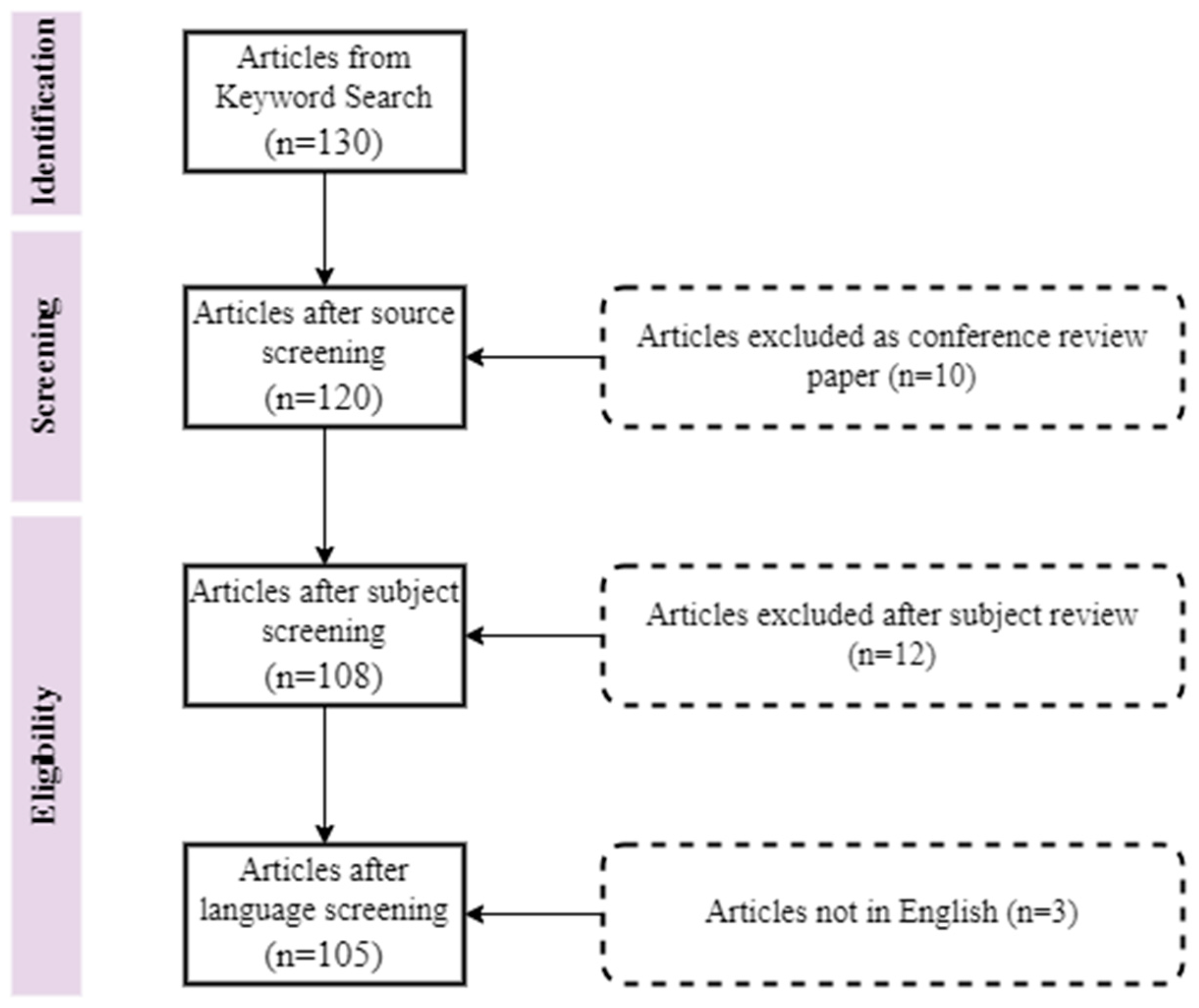




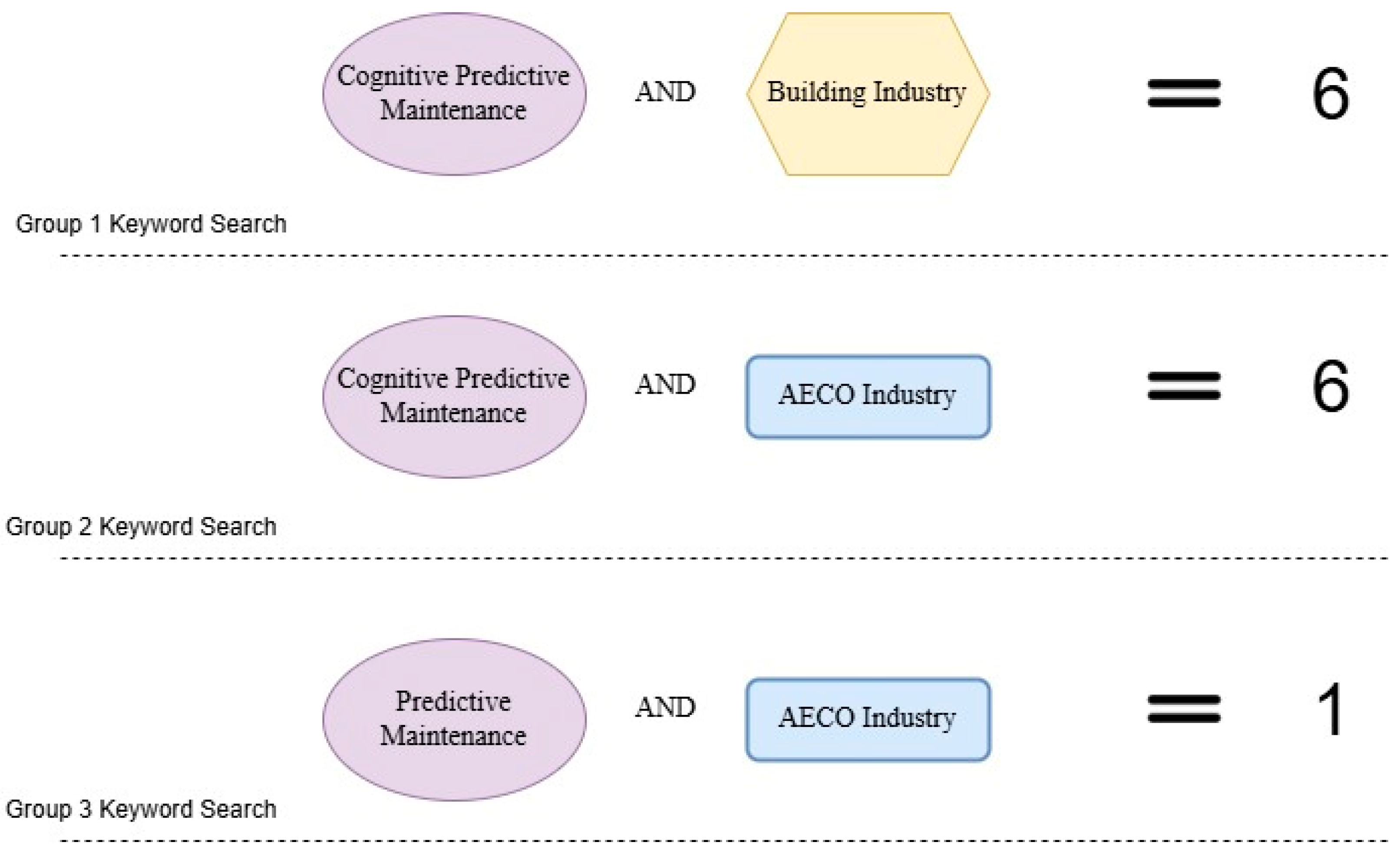

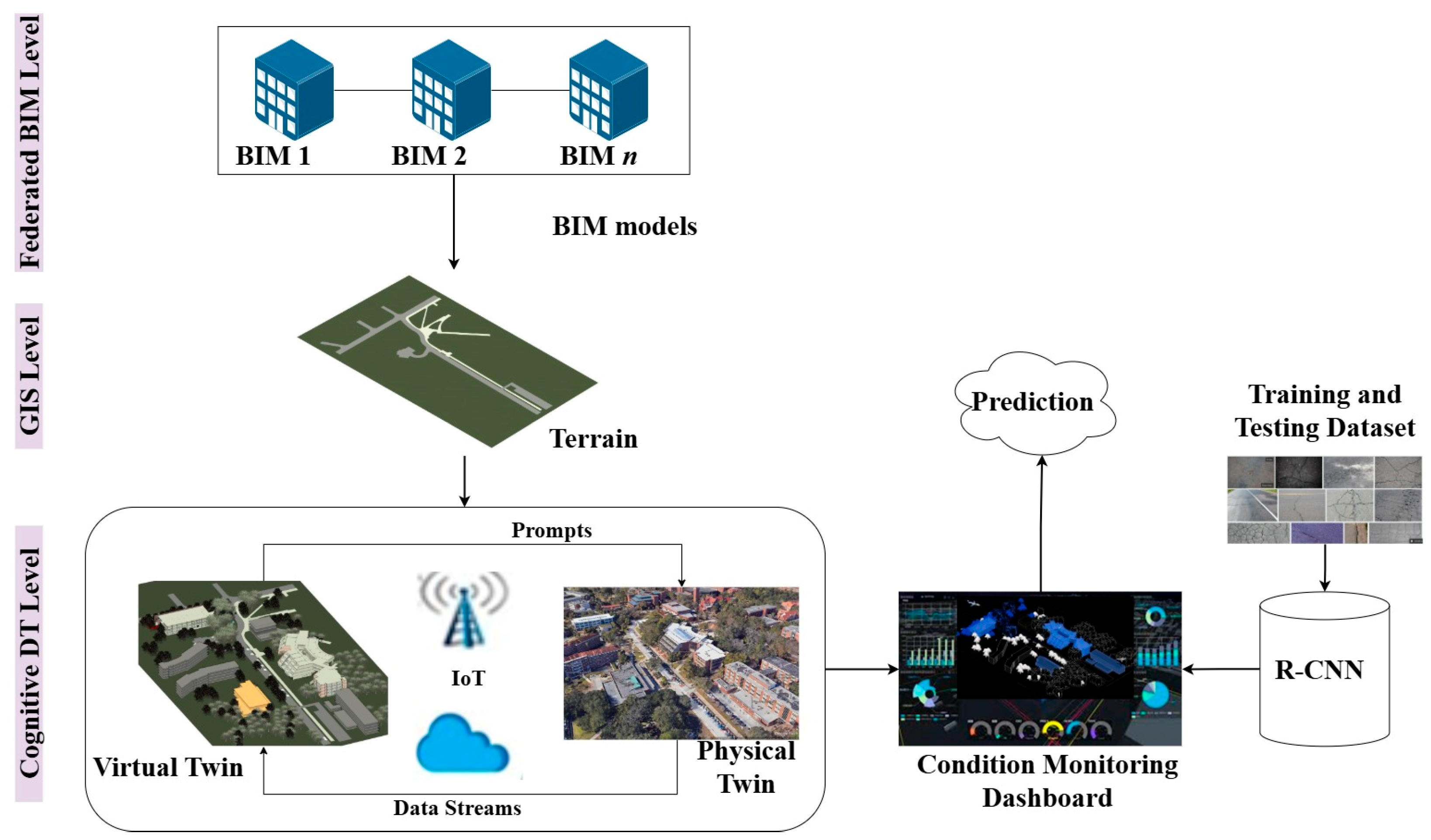

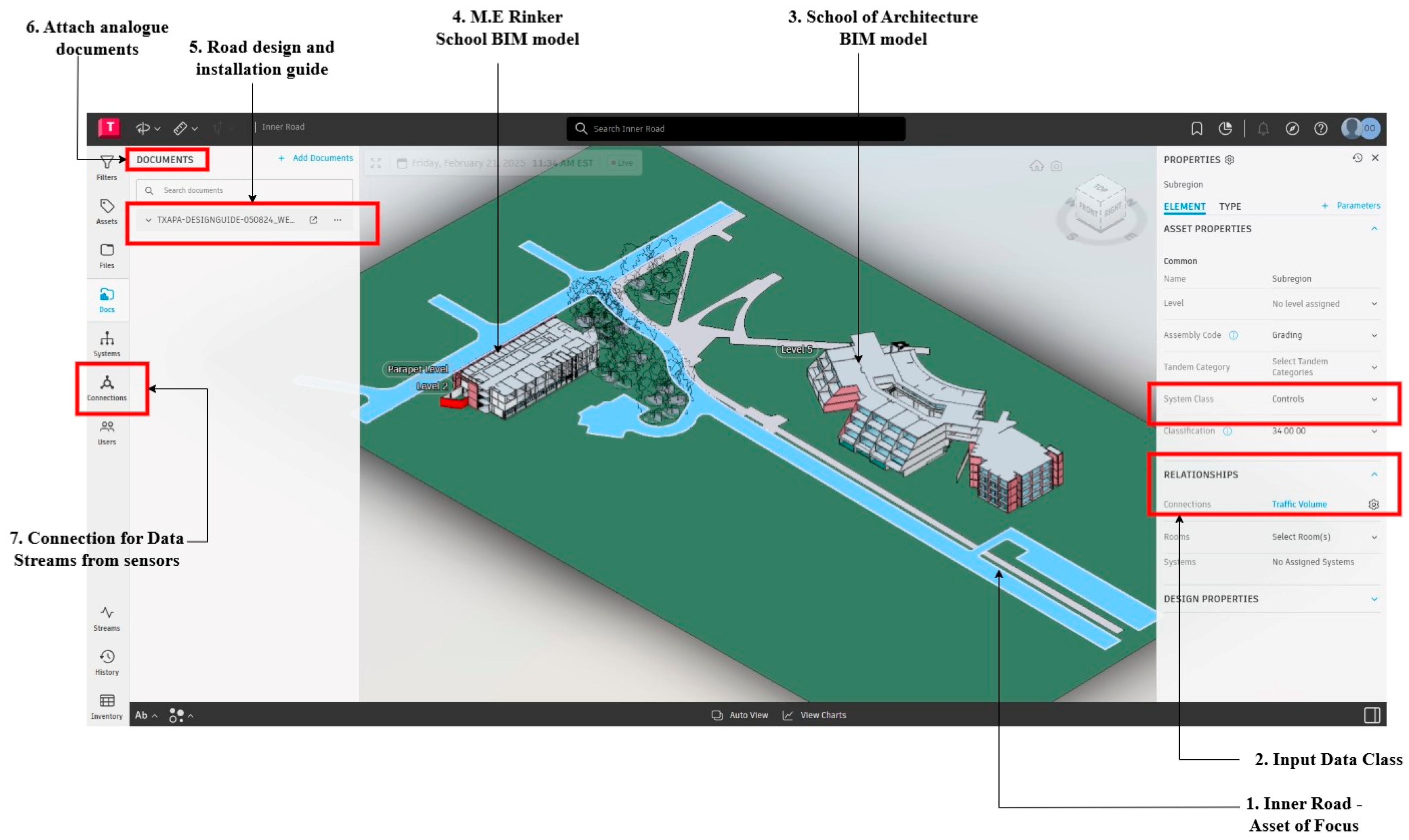

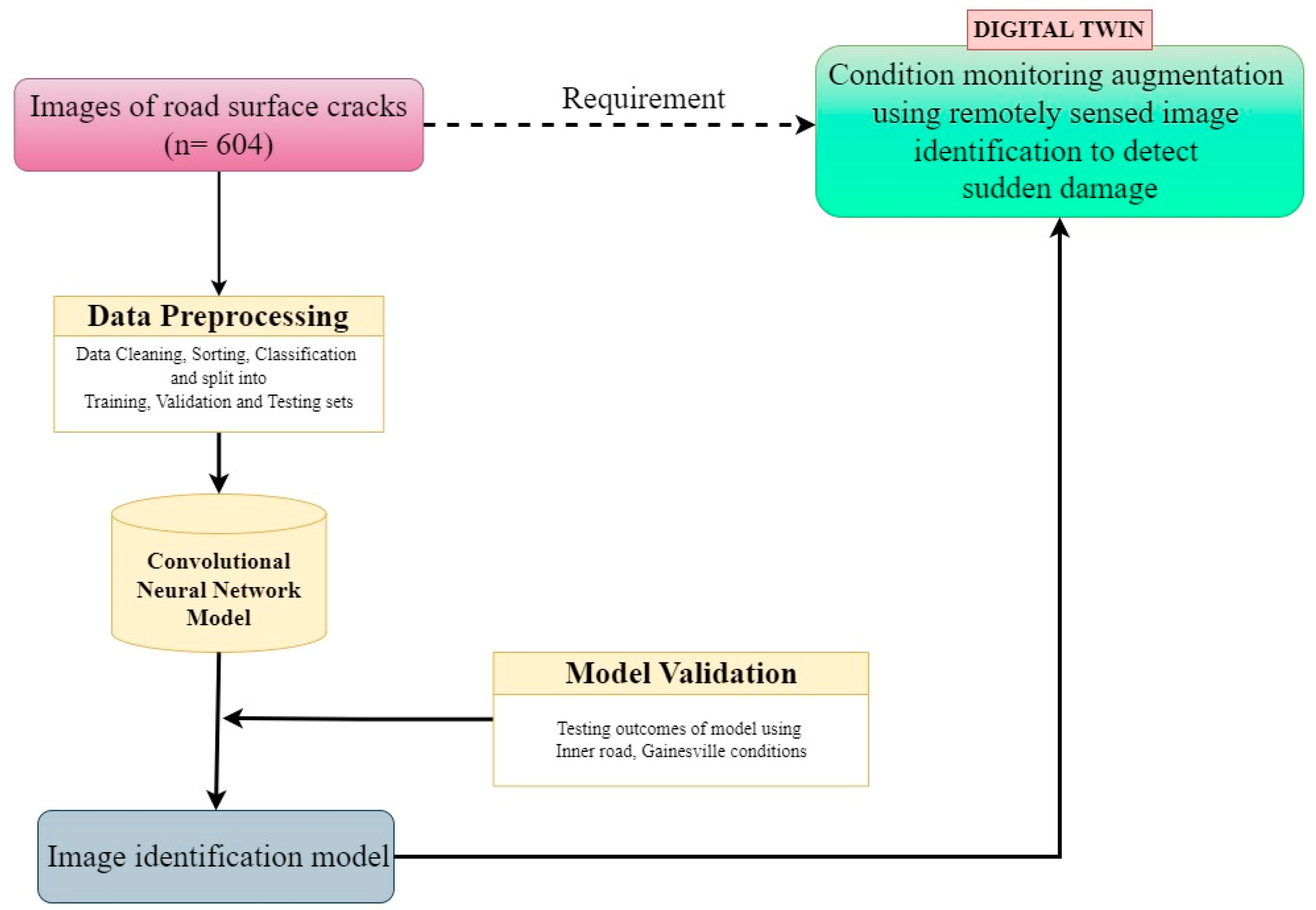


| Theme | Maritime | Manufacturing | General DT | Power | AECO | Infrastructure | Aviation/Aerospace | Industrial/Oil and Gas |
|---|---|---|---|---|---|---|---|---|
| Review of prior art, literature and case studies to examine existing research endeavors, level of applications and future opportunities. | [31,34,54] | [55,56,57] | [58] | [7,59,60] | [61,62] | [37,41] | ||
| Integration with Industry 4.0 and other emerging technologies towards developing a new paradigm contributes to smart infrastructure | [20] | [30,63,64,65,66,67] | [68] | [69] | [51] | [48] | [70,71] | |
| Application of machine learning, deep learning and neural network techniques | [5,21,27,28,72,73,74,75] | [22,76] | [25,77] | [78] | [46,79,80] | [39] | [42,44,81,82] | |
| Condition monitoring and smart manufacturing, predictive maintenance, fault detection and diagnostics | [32] | [2,4,16,23,24,26,83,84,85,86] | [38,87,88] | [3,15,47,49,89] | [90] | [45,91,92] | ||
| Integration with blockchain, edge computing, cloud computing and IoT | [93] | [50] | [8] | |||||
| Quest for reduced “human in the loop” intervention, towards smart predictive maintenance through automation and ultimately autonomy | [33] | [13,29] | [94] | [95] | [43] |
| Theme | General DT | AECO | Aviation/Aerospace |
|---|---|---|---|
| Review of prior art, literature and case studies to examine existing research endeavors, level of applications and future opportunities. | [97] | [98] | |
| Integration with Industry 4.0 and other emerging technologies towards developing a new paradigm contributes to smart infrastructure | [99] | ||
| Application of machine learning, deep learning and neural network techniques | [100] | ||
| Integration with blockchain, edge computing, cloud computing and IoT | [100,101] |
Disclaimer/Publisher’s Note: The statements, opinions and data contained in all publications are solely those of the individual author(s) and contributor(s) and not of MDPI and/or the editor(s). MDPI and/or the editor(s) disclaim responsibility for any injury to people or property resulting from any ideas, methods, instructions or products referred to in the content. |
© 2025 by the authors. Licensee MDPI, Basel, Switzerland. This article is an open access article distributed under the terms and conditions of the Creative Commons Attribution (CC BY) license (https://creativecommons.org/licenses/by/4.0/).
Share and Cite
Lawal, O.O.; Nawari, N.O.; Lawal, O. AI-Enabled Cognitive Predictive Maintenance of Urban Assets Using City Information Modeling—Systematic Review. Buildings 2025, 15, 690. https://doi.org/10.3390/buildings15050690
Lawal OO, Nawari NO, Lawal O. AI-Enabled Cognitive Predictive Maintenance of Urban Assets Using City Information Modeling—Systematic Review. Buildings. 2025; 15(5):690. https://doi.org/10.3390/buildings15050690
Chicago/Turabian StyleLawal, Oluwatoyin O., Nawari O. Nawari, and Omobolaji Lawal. 2025. "AI-Enabled Cognitive Predictive Maintenance of Urban Assets Using City Information Modeling—Systematic Review" Buildings 15, no. 5: 690. https://doi.org/10.3390/buildings15050690
APA StyleLawal, O. O., Nawari, N. O., & Lawal, O. (2025). AI-Enabled Cognitive Predictive Maintenance of Urban Assets Using City Information Modeling—Systematic Review. Buildings, 15(5), 690. https://doi.org/10.3390/buildings15050690






